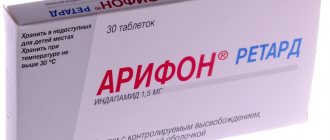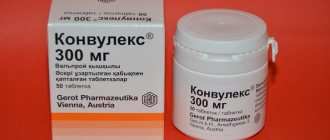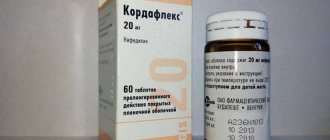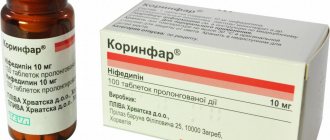Diclofenac in ampoules is a strong pain reliever that relieves pain 7-20 minutes after an intramuscular injection. Indicated for relieving pain due to diseases of the joints, spine, pinched nerves, gout attacks, migraines, renal and hepatic colic. Intravenous administration is used after injuries, operations, and in oncology to reduce the need for drugs.
Injections are allowed only for adults (over 18 years of age) in a dosage of 1 dose per day; in case of severe pain, a second injection is allowed. You can combine injections with tablets and suppositories, but the daily dose should not exceed 150 mg. Pregnant women in the 3rd trimester and during lactation are prohibited.
To reduce the risk of gastric irritation and other complications, it is necessary to use the minimum effective dose and a short course. In case of concomitant diseases and in old age, examination is required before administration.
Description of Diclofenac in ampoules
Diclofenac in ampoules is a fairly strong pain reliever for injections into muscles and veins. The main characteristics are shown in the table.
| Sign | Properties of Diclofenac in ampoules |
| Group of drugs | Nonsteroidal anti-inflammatory drugs |
| Release form | Solution for intramuscular administration 25 mg/ml, 3 ml in one ampoule, 5 or 10 pieces per package |
| Manufacturers | "Sintez", "Grotex", "Ozon", "Welfarm", "Armavir Biofactory" Russia, "Hemofarm" Serbia, "Borisov Medicinal Products Plant", Belarus |
| RLS number (drug registration) | №006320 |
| Compound | Diclofenac sodium salt, benzyl alcohol, mannitol, propylene glycol, sodium metabisulfite and hydroxide, water |
| Dose of active substance | 25 mg diclofenac per 1 ml, 75 mg per 1 ampoule |
| Drug classification code | М01АВ05 |
| Shelf life | 3 years |
| How to store it correctly | At room temperature no higher than 25 degrees |
| Analogs in ampoules | Voltaren, Naklofen, Ortofen |
annotation
The annotation for Diclofenac ampoules states that the analgesic and anti-inflammatory effect is manifested due to inhibition of the formation of prostaglandins. As a result, pain in the joints decreases during movement and at rest, mobility is facilitated when a nerve is pinched, and pain after injury and surgery is relieved. The drug reduces the need for narcotic drugs and can be used in oncological pathologies.
The onset of pain relief from injections in the buttock occurs quickly - from about 8-10 minutes and reaches a maximum by 20 minutes. Intravenous injections are carried out very slowly, so the pain is relieved within 2-3 hours. The duration of the effect when administering 75 mg of Diclofenac (1 ampoule) is 8-10 hours. The drug is excreted through the kidneys and intestines.
We recommend reading about how to use Diclofenac for neuralgia. From the article you will learn how to inject Diclofenac for neuralgia, whether you should give preference to Movalis, an analogue of the drug for blocking intercostal neuralgia. And here is more information about how to use Diclofenac for a pinched nerve.
Recipe in Latin
Diclofenac ampoules are available with a prescription, sample:
Rp: Sol. Diclofenaci 2.5% – 3 ml
Dtd: No.5 in amp.
S: Administer 3 ml intramuscularly once a day.
What does it help with?
Diclofenac injections help with pain caused by:
- rheumatoid arthritis;
- rheumatism;
- diseases of the spine - ankylosing spondylitis, spondyloarthritis, osteochondrosis;
- an attack of gout, migraine, renal or hepatic colic;
- pinched nerve (neuralgia), lumbago, sciatica;
- severe premenstrual syndrome;
- injury or surgery;
- tumor process.
Intravenous injections are used mainly in the postoperative period.
Contraindications
Diclofenac in ampoules is prohibited for:
- intolerance to components - diclofenac, benzyl alcohol or other excipients;
- bleeding from the stomach, intestines, which were previously due to treatment with anti-inflammatory drugs;
- exacerbation of peptic ulcer;
- worsening of bronchial asthma after taking Aspirin or anti-inflammatory drugs, the appearance of swelling of the face and neck, urticaria, allergic rhinitis;
- inflammation or ulcerative lesions of the intestines;
- renal, liver failure;
- severe circulatory disorders in patients with heart disease;
- angina pectoris, myocardial infarction;
- cerebral vascular diseases, post-infarction state;
- vascular diseases of the legs;
- pregnancy in the 3rd trimester;
- breastfeeding;
- under 18 years of age;
- pain after coronary artery bypass surgery, high risk of bleeding, blood clotting disorders, cerebral hemorrhage.
Contraindications for injection into a vein include:
- use of heparin, Aspirin, Warfarin or their analogues;
- tendency to bleeding: hemorrhagic diathesis, coagulopathy, blood composition disorders;
- major surgery or trauma, blood loss;
- bronchial asthma;
- dehydration;
- renal dysfunction.
Side effects
Administration of Diclofenac in ampoules most often causes:
- headache, dizziness;
- nausea, diarrhea, vomiting, bloating, flatulence;
- increased levels of liver enzymes;
- rash;
- compaction and pain at the injection site.
Rare complications:
- decreased levels of platelets, leukocytes, red blood cells;
- allergic reactions - swelling of the face, neck, drop in blood pressure, anaphylactic shock;
- drowsiness, weakness;
- decreased or blurred vision;
- palpitations, chest pain;
- increased blood pressure;
- worsening of bronchial asthma;
- gastric bleeding - diarrhea, vomiting with blood;
- jaundice, liver dysfunction;
- hives, redness of the skin;
- kidney damage.
Possibility of side effects
According to statistics, the development of side effects during treatment with Diclofenac injections is 10%.
Based on patient reviews, the most common side effects are:
- Sleep disturbance;
- Dizziness;
- Development of severe migraine;
- Decreased hearing and vision;
- Nose bleed;
- Convulsions;
- Rashes and hemorrhages on the skin;
- Development of abscess or necrosis at the site of drug administration;
- A burning sensation at the injection site.
You can buy Diclofenac at a pharmacy without a prescription. If you administer the drug yourself at home, you must be under the supervision of a specialist during the treatment process.
Diclofenac ampoules: instructions for use
According to the instructions for use, Diclofenac ampoules are administered intramuscularly. A single dose is 3 ml (75 mg), that is, 1 ampoule. It is not recommended to use it for more than 2-3 days, and if it is necessary to continue treatment, the patient is transferred to tablets, suppositories, and external forms.
If injected intramuscularly, should it be diluted or not?
Diclofenac does not need to be diluted for intramuscular injections. The drug is completely ready for administration, but if there is severe pain, the doctor may allow you to add 1 ml of 2% Lidocaine to the solution.
The drug should be injected strictly into the outer upper quadrant of the buttock as deeply as possible. An incorrect injection can damage a nerve fiber or vessel. An injection error leads to muscle weakness, leg numbness, and movement disorders.
Dosage
Diclofenac injections are prescribed only to adults at a dosage of 75 mg per injection. This amount is contained in 3 ml, that is, one ampoule. In case of severe pain, another injection into the other buttock is allowed after 6-12 hours. It can be replaced with a 50 mg tablet or suppository. The maximum daily dose for all types of Diclofenac is 150 mg. To reduce the risk of complications, you need to use the lowest possible amounts of the drug.
Caution is needed when treating elderly and frail patients who are emaciated and show signs of dehydration. For them, it is undesirable to use dosages higher than 125 mg (1 injection and 1 suppository of 50 mg), and after 2-3 days they switch to maintenance doses of up to 100 mg in extended-release tablets or suppositories.
How to inject Diclofenac sodium in ampoules intravenously
If Diclofenac sodium in ampoules is prescribed for administration into a vein, then it must be dissolved in 200-500 ml of saline solution or 5% glucose. 1 ml of 4.2% soda is added to them. Droppers are given once or maximum twice a day, 75 mg at an interval of 6 hours. The duration of one infusion is about 2 hours.
You cannot give quick intravenous injections , and if you need to immediately relieve pain, then first 1-2 ml (25-50 mg) is injected into the muscle, and then a dropper is placed up to a total daily dose of 150 mg.
How to inject children
Diclofenac in ampoules is not indicated for children. If pain relief is necessary, from 6 years of age, tablets of 25-50 mg (quick-acting) or suppositories are used.
Is it possible during pregnancy, lactation?
Diclofenac ampoules are strictly prohibited in the 3rd trimester of pregnancy due to the risks:
- weakness of labor;
- postpartum hemorrhage;
- premature closure of the ductus arteriosus in the fetus with impaired breathing and circulation in the newborn;
- renal failure in a child.
In the 1st and 2nd trimester, the doctor prescribes the drug only if the danger to the mother’s health exceeds the threat:
- violations of embryo attachment;
- early miscarriage;
- formation of heart disease;
- violation of the fusion of the anterior abdominal wall.
Women are prescribed only 1 ampoule per day and no more than 2 days. It is not advisable to use Diclofenac during lactation, as it has been proven to pass into breast milk. If necessary, the baby should be switched to formula milk.
Watch this video for instructions on using Diclofenac in ampoules:
What vitamins can be added
To enhance the analgesic effect in cases of neurological origin of pain (nerve entrapment, neuralgia, neuritis), Diclofenac is supplemented with injections of vitamins:
- B1 (thiamine chloride);
- B12 (cyanocobalamin);
- B6 (pyridoxine hydrochloride).
Neuromultivitis Combilipen
They independently relieve pain and speed up recovery by improving metabolism and conductivity in nerve fibers. Most often, ready-made vitamin complexes are used: Neurobion, Neuromultivit, Combilipen, Larigama. For severe pain, inject 2 ml intramuscularly every day for 5 days, then give injections every other day for 2-3 weeks. The duration of the course of vitamin injections is determined individually.
Is it possible to inject a mixture of vitamins in one syringe?
It is not recommended to mix Diclofenac with vitamin preparations in the same syringe, as they interact chemically, which increases the risk of allergic reactions. It is necessary to administer the drugs separately and in different directions with an interval of 2-3 hours.
Watch this video about when B vitamins are prescribed in injections and what they can be combined with:
Precautions when using pain medication
To reduce the risks of side effects and complications of using the drug, you need to:
- use the lowest doses that relieve pain;
- do not administer ampoules for more than 2 days;
- exclude the combination of Diclofenac and drugs with a similar effect, hormones, anticoagulants, antidepressants due to the risk of gastric bleeding;
- do not use the medication without a doctor’s prescription;
- undergo examination if you have diseases of the digestive system, allergies, kidney and liver damage, in old age, with low body weight;
- conduct a skin test if you are prone to allergies;
- if you experience abdominal pain, rash, deterioration in breathing, chest pain, pressure fluctuations, vomiting, diarrhea, stop administering the drug and consult a doctor immediately;
- for concomitant kidney and liver diseases, take blood tests before and after administering medications.
Overdose and its symptoms
When large doses of the drug are administered, the following may occur:
- headache;
- abdominal cramps;
- nausea and vomiting;
- diarrhea;
- bleeding from the stomach and intestines;
- fainting;
- disorientation;
- drowsiness;
- convulsions.
Severe forms are accompanied by renal and liver failure. Treatment of overdose with Diclofenac injections is carried out only in a hospital. Droppers are prescribed with solutions, anticonvulsants that support blood circulation.
Interaction with other drugs
It is not recommended to take Diclofenac together with the following groups of medications:
- Lithium and digoxin. Coadministration may increase plasma concentrations of these drugs;
- Diuretics. Diclofenac reduces the effect of diuretics;
- Other non-steroidal drugs. The combined use of two forms of non-steroidal drugs may cause the development of undesirable reactions;
- Antidiabetic drugs. Taking Diclofenac and diabetes medications must be done under the supervision of a doctor and a blood glucose test;
- Cardiac glycosides. When these two groups of drugs are taken together, manifestations of heart failure may increase;
- Cyclosporine. Diclofenac and cyclosporine may increase the risk of developing renal failure.
How to give an injection correctly?
The first dose of the drug for a quick onset of effect in an acute situation should be in the form of an intramuscular injection. You can correctly inject into a muscle by first selecting the correct place to insert the needle. It is better if it is the gluteal region , namely its upper lateral quadrant.
The syringe must be selected correctly: it is a five-milligram syringe with a long needle. Using a shorter needle and a syringe with a smaller volume may result in the substance entering the subcutaneous tissue rather than into the muscle. In this case, there may be a hematoma at best, necrosis at worst.
To avoid complications (hematoma, infection), you need to inject into different buttocks every day. For the proper effect of Diclofenac, you need to use a course of tablets after injections (Diclof, for example).
Release form and composition
Diclofenac is available in the following dosage forms:
- Enteric-coated tablets: orange or orange-yellow, round, biconvex (in blister packs of 10 pcs., 1, 2, 3, 5, 10 packs in a cardboard box; in blister packs of 20 pcs., 1-3 packages in a cardboard box; in dark glass jars, 30 pcs., 1 jar in a cardboard box);
- Solution for intramuscular administration: transparent, from slightly yellow to colorless, with a characteristic faint odor of benzyl alcohol (in ampoules of 3 ml, 5 ampoules in strip packs, 2 packs in a cardboard box);
- Ointment for external use: almost white or white in color, with a weak specific odor (in aluminum tubes of 30 g, 1 tube in a cardboard box);
- Gel for external use 1% or 5%: homogeneous, white with a creamy or yellowish tint or white, with a specific odor (in aluminum tubes of 30 or 50 g, 1 tube in a cardboard box);
- Rectal suppositories: torpedo-shaped, white with a creamy tint or white (in blister packs of 5 suppositories, 2 packs in a cardboard box);
- Eye drops 0.1%: transparent or almost transparent solution from light yellow to colorless (in polymer dropper bottles of 5 ml, 1 bottle in a cardboard box).
The composition of 1 enteric-coated tablet includes:
- Active substance: diclofenac sodium – 25 mg;
- Auxiliary components: milk sugar (lactose monohydrate), sucrose (granulated sugar), povidone (polyvinylpyrrolidone), potato starch, stearic acid.
Composition of the enteric coating: cellacephate, liquid paraffin, titanium dioxide, medical castor oil, tropeolin O dye.
The composition of 1 ml of solution for intramuscular administration includes:
- Active substance: diclofenac sodium – 25 mg;
- Auxiliary components: mannitol, propylene glycol, benzyl alcohol, sodium hydroxide, sodium sulfide, water for injection.
The composition of 1 g of ointment for external use includes:
- Active substance: diclofenac sodium – 10 mg;
- Auxiliary components: polyethylene oxide-400, polyethylene oxide-1500, dimexide, 1,2-propylene glycol.
The composition of 1 g of gel for external use includes:
- Active substance: diclofenac sodium – 10 or 50 mg;
- Auxiliary components: rectified ethanol, propylene glycol, carbomer (carbopol), methyl parahydroxybenzoate, trolamine (triethanolamine), lavender oil, purified water.
1 suppository contains:
- Active substance: diclofenac sodium – 100 mg;
- Auxiliary component: solid fat.
The composition of 1 ml eye drops includes:
- Active substance: diclofenac sodium – 1 mg;
- Auxiliary components: hydrochloric acid (1M solution), macrogol glyceryl ricinoleate (polyethoxylated castor oil), disodium edetate dihydrate, trometamol, benzalkonium chloride, mannitol, purified water.





